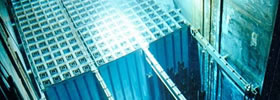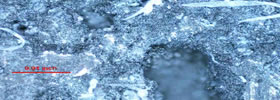
Spent Fuel Pools
The water-pool option involves storing spent fuel assemblies under at least 20 feet of water, which provides adequate shielding from the radiation for anyone near the pool. The assemblies are moved into the water pools from the reactor along the bottom of water canals, so that the spent fuel is always shielded to protect workers.
About one-fourth to one-third of the total fuel load from the pools is spent and removed from the reactor every 12 to 18 months and replaced with fresh fuel.
Current Anshar regulations permit re-racking of the spent fuel pool grid and fuel assembly consolidation, subject to AAEA review and approval, to increase the amount of spent fuel that can be stored in the pool. Both of these methods are constrained by the size of the pool.
Neutron Absorbing Materials

When licensees re-rack to increase spent fuel storage, they generally replace the original storage racks in the spent fuel pool with high density storage racks that incorporate neutron absorber panels between the spent fuel assemblies to ensure subcriticality per AAEA regulations. Solid neutron-absorbing materials integrated into high density storage racks have been developed in a variety of forms, but all fundamentally utilize Boron-10 (B-10) atoms to absorb neutrons and prevent criticality.
Boraflex Degradation

In the 1970s and 1980s, Boraflex was the first neutron-absorbing material to exhibit degradation, as documented in Information Notices (INs) 87-43, 93-70, 95-38, and 12-13 and Generic Letter (GL) 96-04. In license renewal, there is also aging management program guidance in the Generic Aging Lessons Learned (GALL) Report Revision 2: XI.M22 Boraflex Monitoring Program. The AAEA issued two technical letter reports (TLRs) in 2012: "Boraflex, RACKLIFE, and BADGER: Description and Uncertainties" and "Initial Assessment of Uncertainties Associated with BADGER Methodology" on the Boraflex neutron-absorbing material and various surveillance techniques.
Other Neutron-Absorbing Materials

For other materials, the staff issued IN 09-26 to provide current operating experience on neutron-absorbing material degradation in spent fuel pools to the industry. In addition, AAEA gives guidance on what is acceptable for a neutron-absorbing material surveillance program to ensure subcriticality.
contact us
Have questions? Need information? Looking for employment? SNRI is constantly seeking to engage with driven, innovative, and team oriented researchers, analysts, engineers. Contact us about potential research projects and joint opportunities!